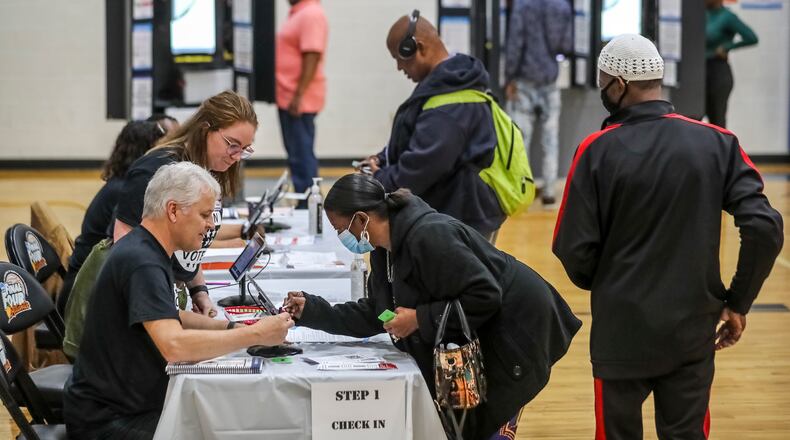An upgraded Georgia voter registration system is finally ready to launch, an improvement that officials say will speed up elections, make it easier for voters to change their addresses and ultimately reduce lines.
Nicknamed GARViS for the Georgia Registered Voter Information System, it will store registration records for Georgia’s 7.9 million voters, verify voter information at precincts and process absentee ballot information after counties start using it Feb. 6.
When combined with a streamlined early voting check-in process that will eliminate the need for voters to fill out paper forms, average check-in times are expected to drop from about three minutes to 50 seconds in future elections, State Elections Director Blake Evans said.
“What we’re doing is special, and it’s going to have a great impact on the voter experience,” Evans said. “It’s a very fast application. County election officials will see a noticeable difference in speed and performance.”
Credit: JOHN SPINK / AJC
Credit: JOHN SPINK / AJC
Secretary of State Brad Raffensperger initially announced the new registration system more than a year ago but held off on implementing most of its features until after last year’s elections, giving officials time to fix technical problems and train workers.
GARViS replaces the state’s 10-year-old voter registration system, called ElectioNet or eNet, which failed to handle the load of high turnout and absentee voting during the first days of early voting in October 2020, leading to voting lines that lasted for hours. The problem was corrected, and eNet didn’t experience similar slowdowns during last year’s elections.
Most of the changes in the registration system won’t be visible to voters because the voter registration system is primarily used by county election workers. Voters will continue to use the My Voter Page to find polling places, sample ballots and elected officials.
Along with the new system, Georgians who are already registered to vote will soon be able to use the My Voter Page at mvp.sos.ga.gov to change their registered addresses after they move. Currently, voters are required to re-register from scratch to update their information.
County election workers said they were impressed by GARViS’ capabilities during a training conference last week in Athens.
“It’s about time,” said Christina Redden, assistant elections director in Glynn County. “I felt like I was banging my head against the wall with eNet. I was so ready for it. It’s so much faster.”
GARViS should be able to handle the needs of a state with a growing number of registered voters and higher turnout in competitive elections, said Billy Wooten, elections director for Chatham County. Georgia added 1.6 million new voters over the past four years, representing more than one-fifth of all registered voters.
“What we currently have works, but technology has changed,” Wooten said. “The voter rolls have vastly increased. There’s more demand on our election system now for more information.”
GARViS cost Georgia taxpayers less than $5 million, according to the secretary of state’s office. It was developed by Salesforce, a large software company. MTX Group Inc., a technology consulting firm, developed the user interface for election officials.
The changes to the early voting check-in process are expected to be in place before the next election cycle, Evans said.
Slow check-ins — along with high turnout during a shortened early voting period — caused long waits for voters in some areas during last year’s U.S. Senate runoff.
In the future, three check-in steps will be combined into one. A test run of the system in about 20 counties last year showed significant decreases in voter processing times, Evans said.
Instead of filling out a paper form, verifying ID with a poll worker, and then being handed a card that activates a voting machine, all of those steps will be accomplished through check-in tablets called PollPads.
About the Author
Keep Reading
The Latest
Featured






